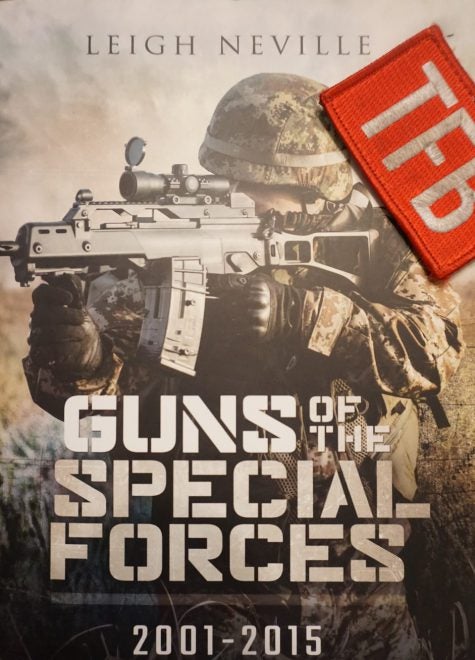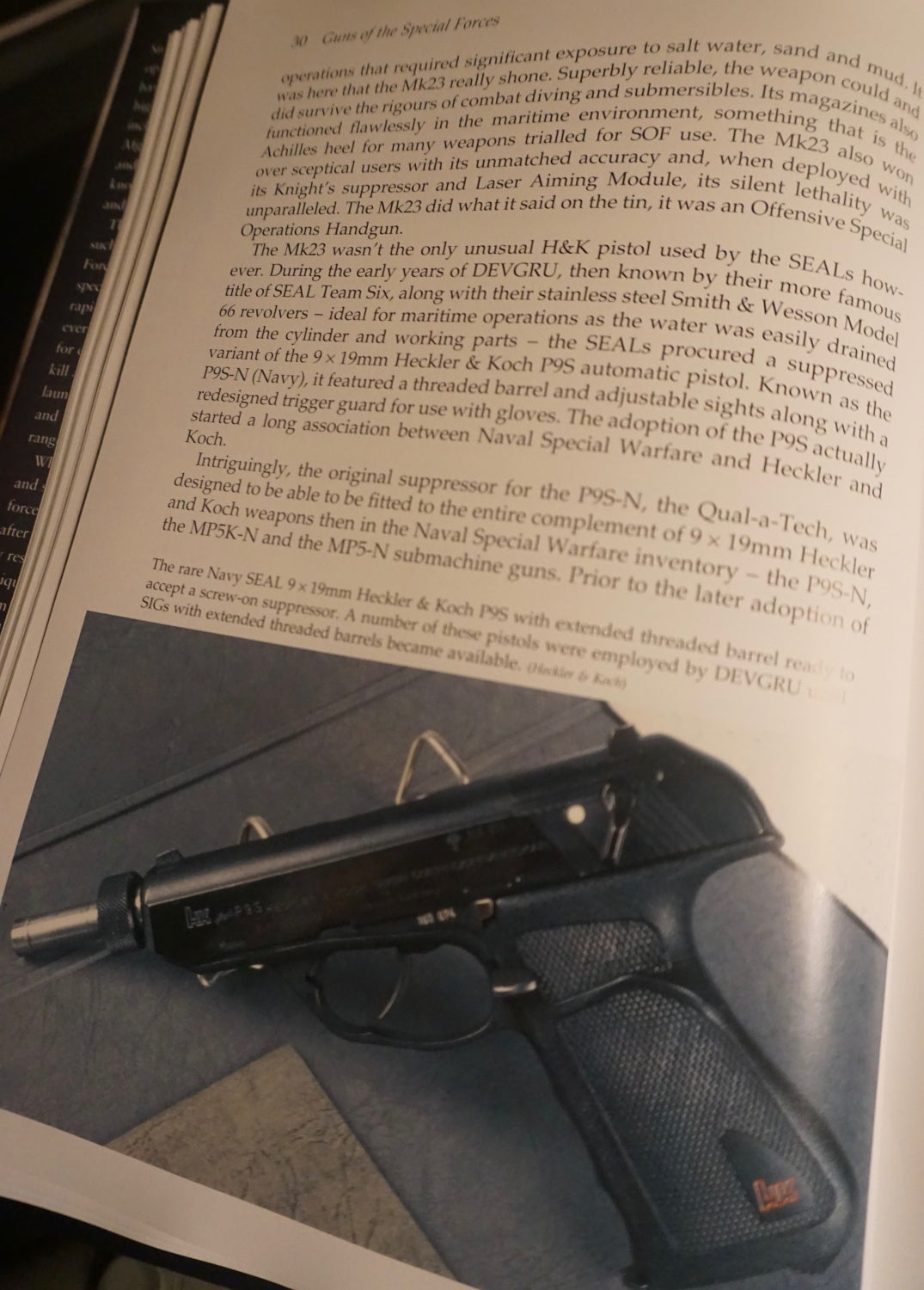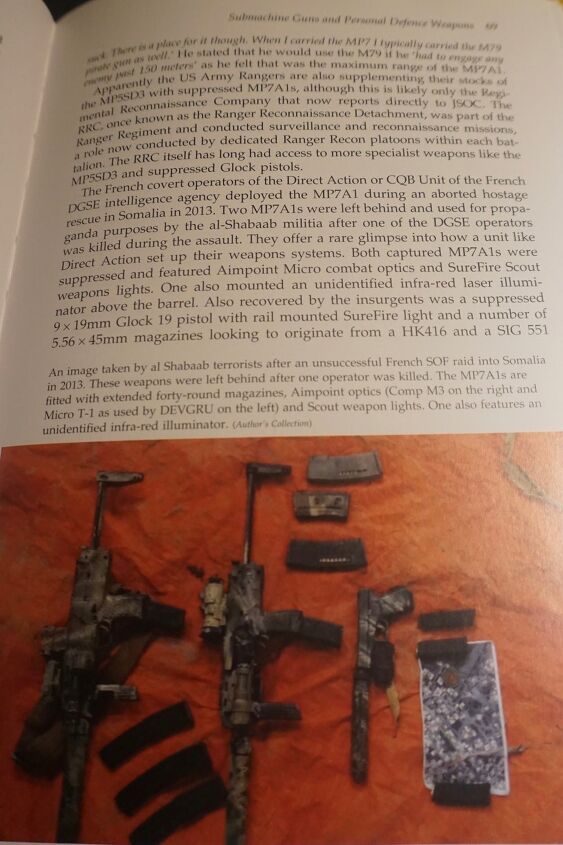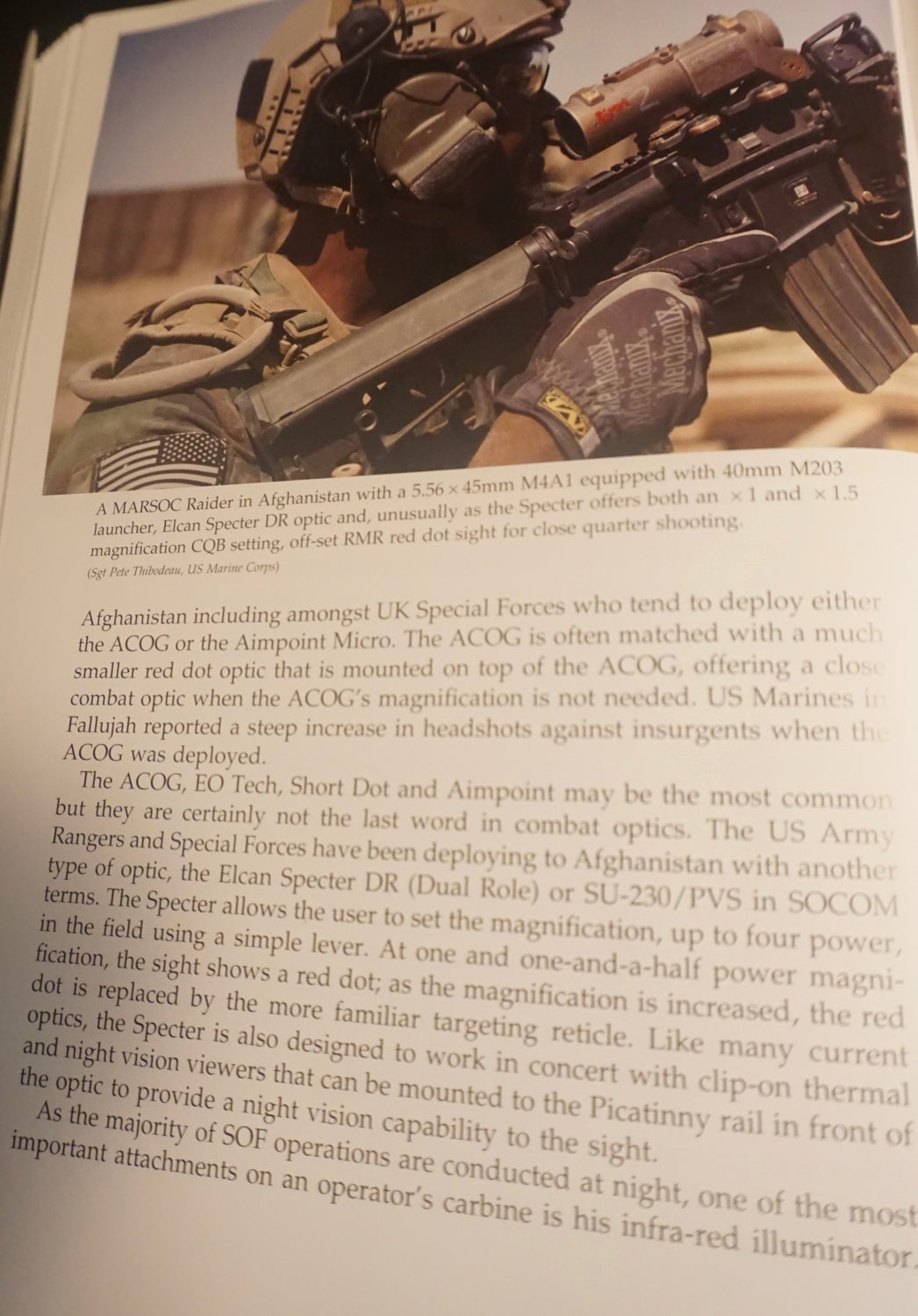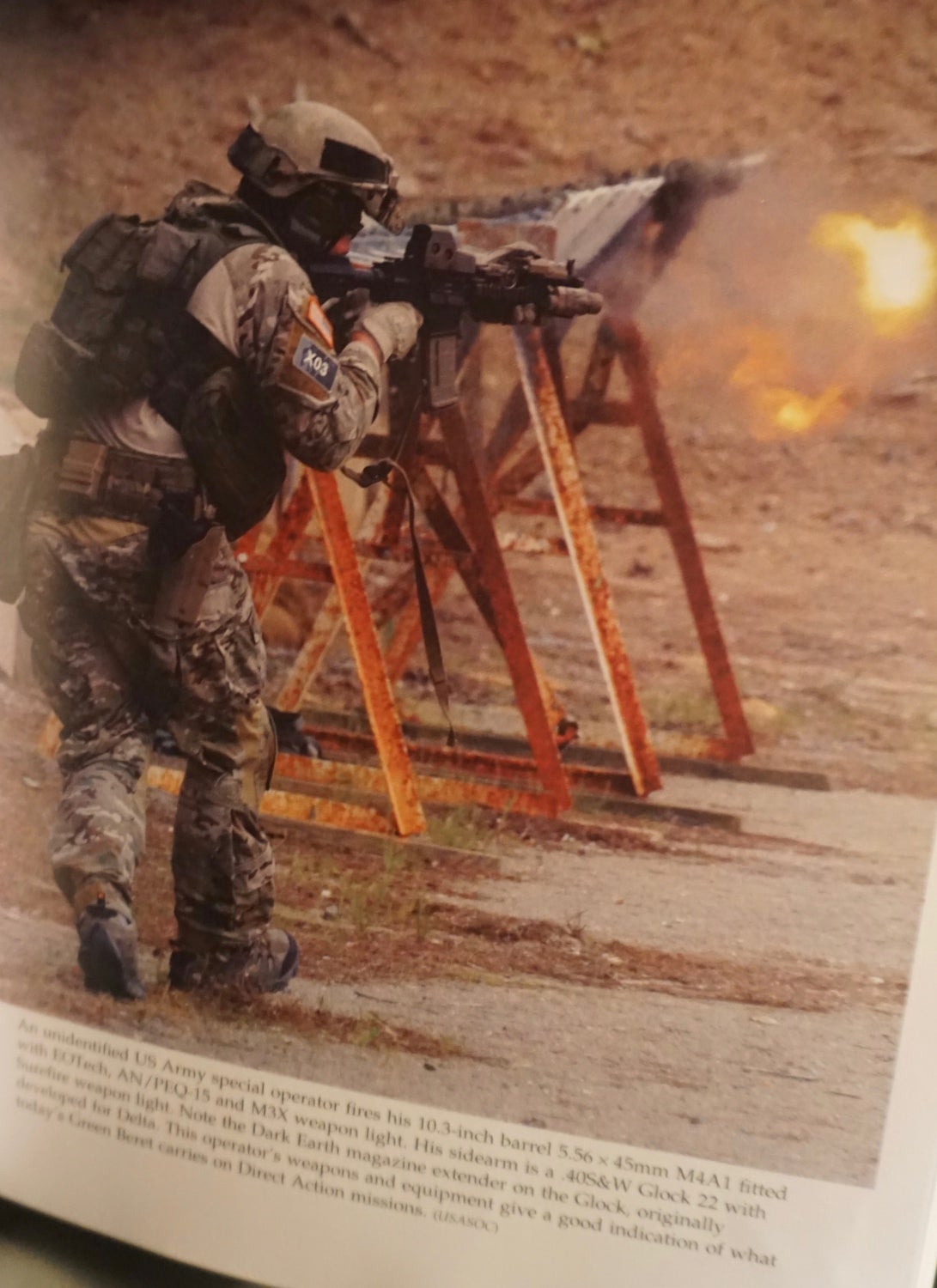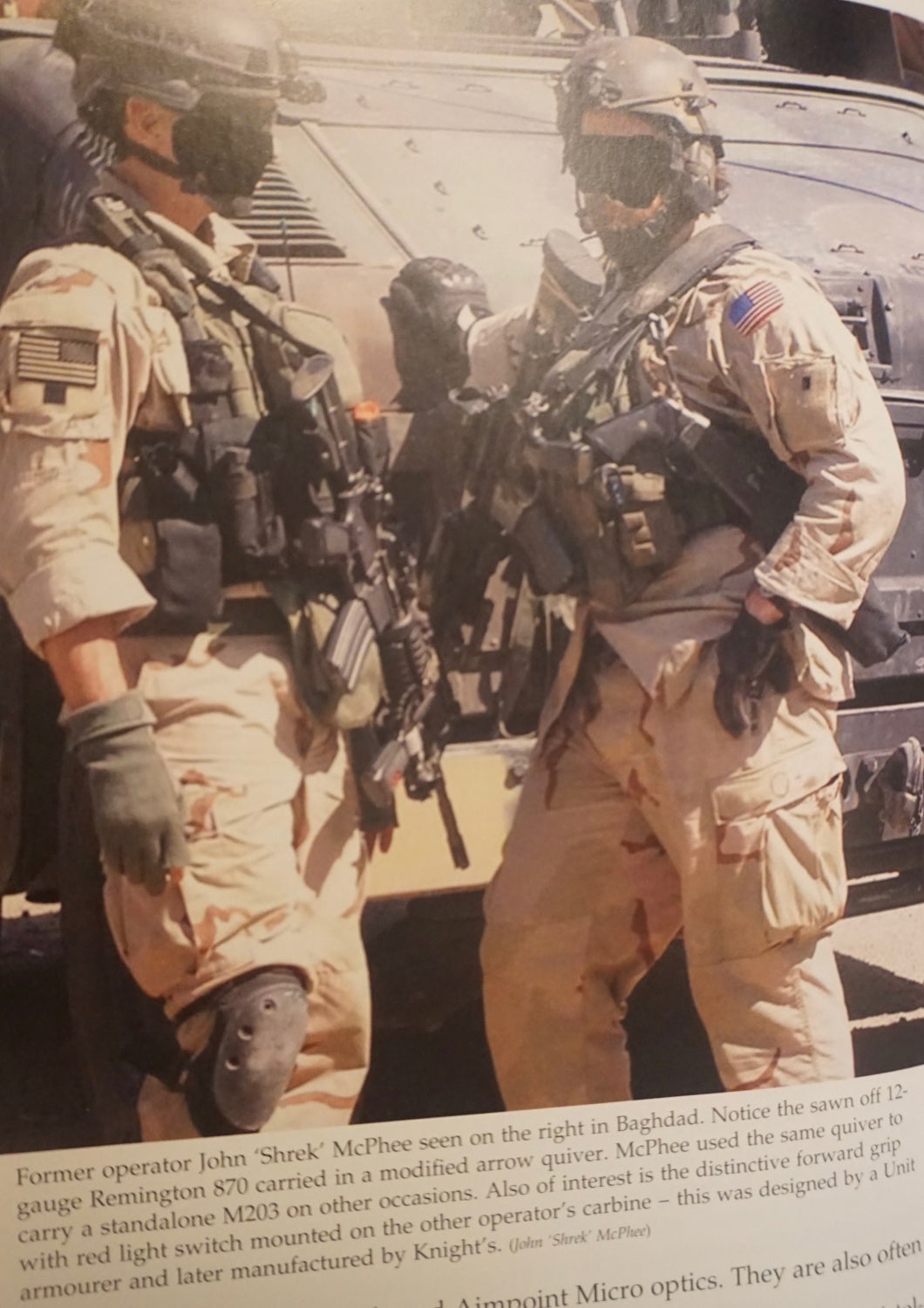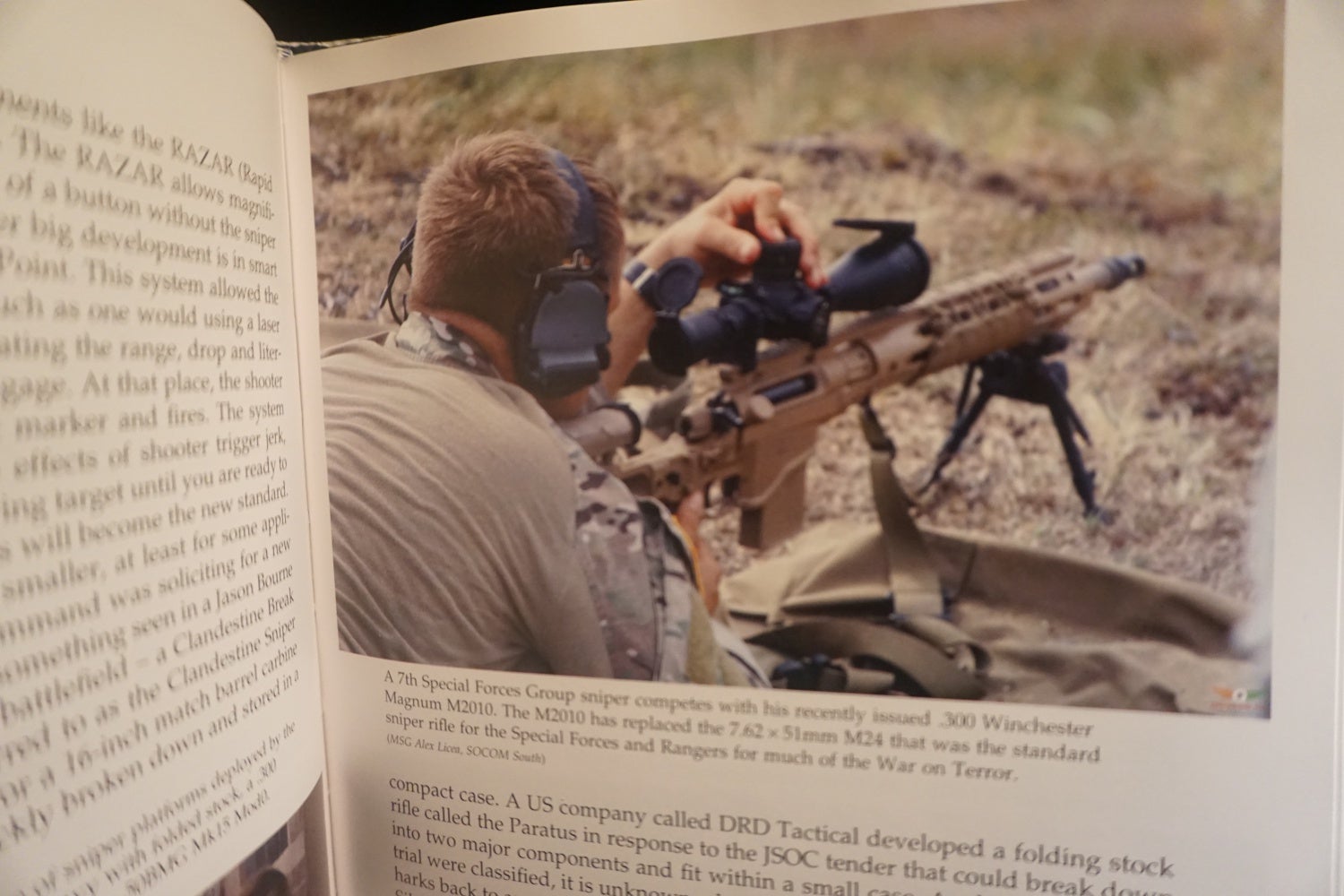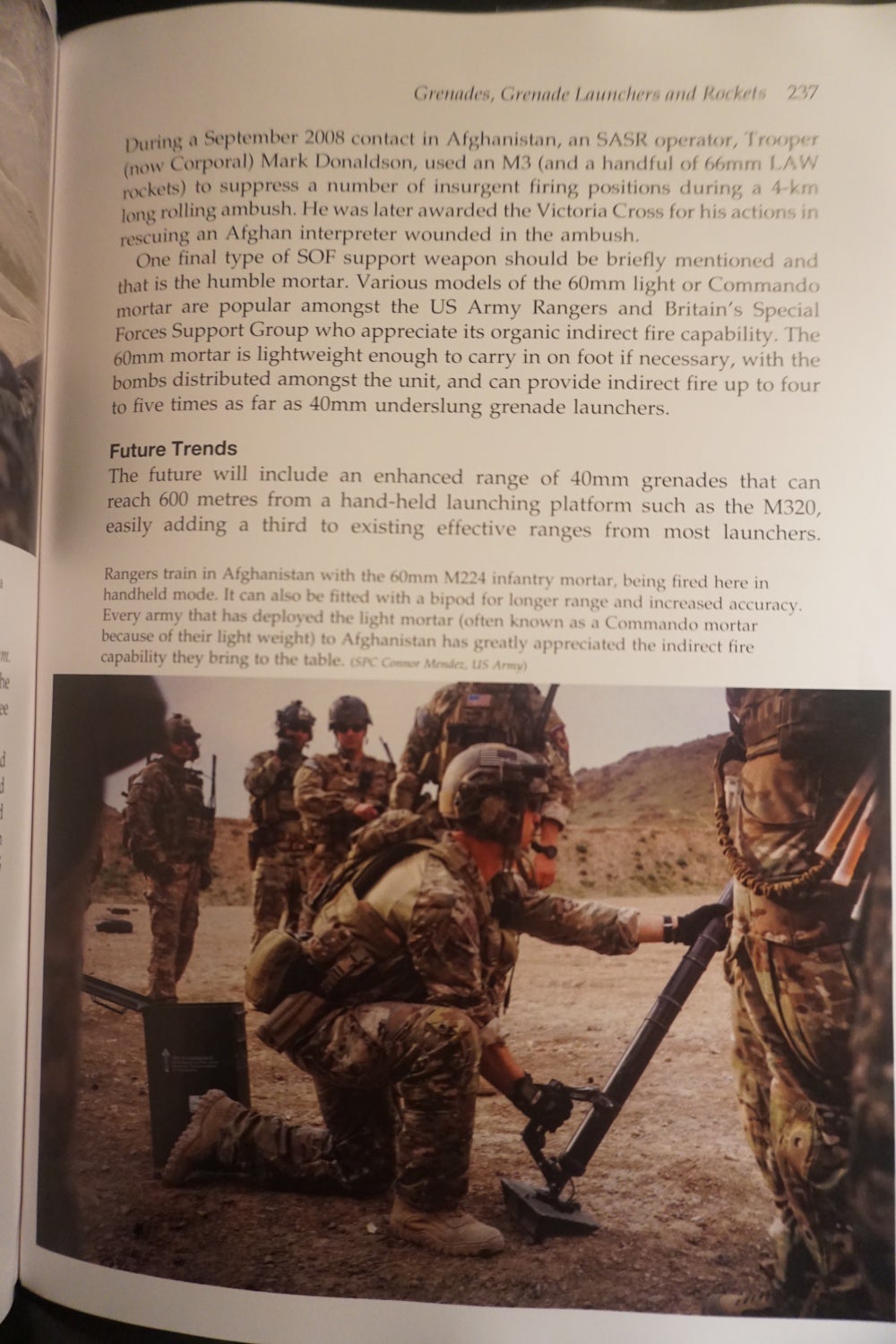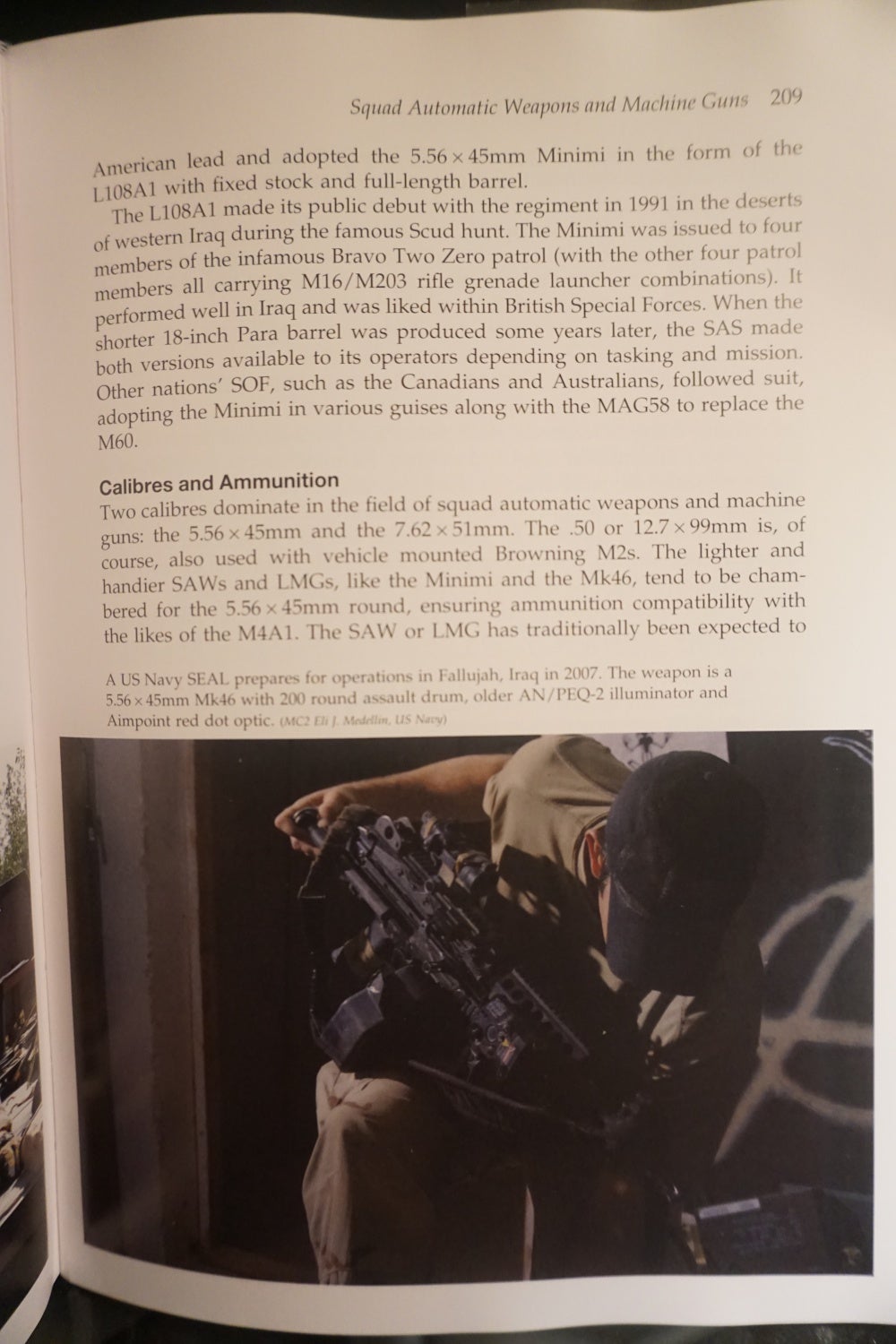Guns of the Special Forces is a recent publication by Pen & Sword Press written by Leigh Neville, an Australian defense and military author. The book is inspired by Guns of the Elite written by George Markham, an in-depth look at the history and then current (1990s) usage of small arms by special operations units in the world. Neville is essentially bringing the SF narrative of small arms knowledge and development up to date, in an extremely well written, 244 page publication filled with excellent description, discussion, and amazing photographs. In fact, I think the photographs are some of the best to appear in print from this secretive community the world over. I’m very used to being awed and seeing a number of photographs from OIF/OEF of SF weapons, but even for me the book blew it out of the park with the selection of pictures.
The book is organized into chapters based on small arms types from Combat Pistols, Submachine Guns & Personal Defense Weapons, Assault Rifles & Carbines, Battle Rifles/Special Purpose & Designated Marksman Rifles, Combat Shotguns, Sniper and Anti-Material Rifles, Squad Automatic Weapons & Machine Guns, Grenades/Grenade Launchers and Rockets, and finally a conclusion with the authors predictions of future trends. Each chapter starts out discussing the initial history of said weapon systems among previous SF groups, most starting with World War Two, and then continuing into the 1990s. As an example with submachine guns discussion starts with the Thompson and Sten usage among the SAS and OSS in World War Two, graduates to the Swedish K in Vietnam, while introducing the MP5 and its impact on SF forces, then to the decline of the submachine gun in favor of PDWs first, and then this decline in favor of 5.56x45mm platforms and finally with a hint that a short .300 Blackout rifle could theoretically make the submachine obsolete because of the dramatic reduction in suppressed sound, barrel length along with folding stock, all previous advantages that historical submachine guns had over their full length intermediate round cousins.
Then the author goes into detail with “Calibre” (those poor Anglos, they must suffer from the misspelling) and Ammunition. Neville makes a very valid point early on with the old adage that, “amateurs talk caliber, professionals talk bullets”. Throughout the book, Neville gets into enormous detail when it comes to dealing with barrel lengths, corresponding with bullet weights, terminal ballistics and how each of these rounds performed overseas. Very importantly he discusses the 5.56 dilemma, highlighting the issues and advances when it came from dealing with 55 grain bullets to the 62 and 77 grain versions all under their assorted designations in the SOCOM and U.S. military community, in addition to mentioning the British L1A1 and L1A2 5.56 round development. Next he goes into Tactics and Techniques, highlighting just how these small arms and ammunition were utilized among various SF groups, giving case studies and examples from SF history. Events include such historic operations as in Somalia 1993, Operation Nimrod, Operation Eagle Claw, Panama and Grenada. Then of course multiple accounts from OIF,OEF, and Syria from a number of SF folks who have been willing to talk publicly about their involvement. Finally Neville highlights certain firearms throughout each chapter, most popularly in use with American and British SF groups. He does mention a number of other countries throughout the book, but he makes a very valid point that American and British SF really do lead the way when it comes to small arms development and usage, enough so that it often gets disseminated to our international allies in a number of forms.
I think the most important contribution Neville has made with the book are the various revolutions and changes that have been ongoing in the small arms world since the 1990s, that stem from small arms and ammunition development within SF groups. I mean, the rise of the Glock, the 9mm/.40 S&W/.45 ACP back and forth, the development of the 5.56mm round, introduction of the .300 Blackout, shorter carbines slowly encroaching on many formally submachine gun domains, the PSR interchangeable caliber rifle, the precision rifle DM concept among both SF groups and line infantry, introduction of magnified optics and reflex sights. All these are extremely important trends that have turned the face of the way we conduct warfare and law enforcement completely on its side compared to pre 9/11 attitudes and tactics. Many of these are so influential that we are yet to see their true influence, and probably won’t for a number of years to come.
The important point here is that the SF groups are really driving this forward momentum through their uncompromising demands for better, lighter, and more lethal small arms capabilities. I mean, this is completely evident in just how much the civilian side of things have absolutely changed as a direct result of dividends received by companies attempts successful or failed at trying to fulfill a SF requirement. The piston operated AR and the HK416/Sig 516 is directly tied into DEVGRUs insistence on a better AR platform. The Sig MCX is out of a direct tender for a .300 Blackout rifle for the Army’s Combat Application Group (CAG, formally known as 1st SFOD- Delta) and a secondary tender for London police CT-SFOs. Short 7.62x51mm ARs being produced by Knight’s come directly from CAG’s attempts at shortening the system for urban sniping in Iraq. H&Ks USP series resulted from the SOCOM Mark 23 handgun which pretty much failed, but spawned a whole era of H&K’s entry into successful handgun design. The list goes on and on, but the point is that there is a number of developments in the civilian side of things that wouldn’t have existed or have been to the point they are at today had the SOCOM side not demanded that ingenuity and product. Nevilles book illustrates this in excellent prose.
Neville also writes extensively about the politics involved with procurement, and how logistics along with costs can really make or break certain issue items. For example he mentions how the 75th Ranger Regiment uses 240Ls that are bought with Big Army money, while their Mk48s come from SOCOM budgets. Thus, the Regiment is able to utilize the best of both worlds, the lightweight M240s, and the newly manufactured Mk48s, without having to resorting to picking one over the other had they just been able to select one good option from the same budget.
The writing style is excellent considering that this book is meant for the general public. Neville doesn’t drown the reader in an ocean of acronyms, and allows the reader to keep pace with the timeline of development. For many readers who are well versed in military small arms and SF application of such, this book is an excellent bringing it all under one fold sort of narrative and will even introduce new items and developments that they might not even have been aware of. For readers that have little to no previously existing knowledge of military small arms, this book will not only introduce them to the bizarre world of special operations armament, but also the important encompassing trends and milestones that have come along the way.
However, nothing is without its detractors, and I would be remiss to not mention any errors I found in it. First off, I found exactly nine nomenclature or misidentification errors throughout the entire text. By these I mean, the author mentioned the expendable Liberator pistol as an M1942 instead of FP-45, calling an Aimpoint optic a Trijicon in one picture caption, mistaking a Skeetir thermal imager for a magnifying switch mount optic (can’t really blame him for that, these optics are extremely rare), mistaking an RM Equipment M203 forward mount for a Troy mount. But overall, considering these were 9 individual items out of over 200 pages filled with text, I would say the author did a better job than most.
The book tends to be Ranger Regiment and ODA photograph heavy. This isn’t a detraction at all, however I would have appreciated some more photographs from SAS/SBS, different European entities, DEVGRU, CAG (some excellent John Mcphee pictures though), Israeli SF, and Russian side of the house. In fact there is very little mention of the Israeli and Russian SF contingents. Neville explained that developing interviews with either of these countries was very difficult because of the language barrier, and thus there is very little direct input from these two sources. Probably more on a personal note in my opinion, but I just feel that the word “operator” is so completely overused in todays small arms verbiage, it’s starting to really get annoying. Operator is used on practically every page of the book. To some this probably is barely worth an afterthought though.
Some of the very individual claims made seem to be a little off, but this is more from the writers research opinion than anything concrete. Neville talks about the Tracking Point system and how it could become more important to the development of sniper rifles, which I think many would disagree with. The company seems to ebb and flow with the times, while putting out an expensive product that has yet to be fully tested in a military capacity. Although this might be the way of the future, I doubt it will be fielded for at least another decade or so, until cost and technology can catch up. I was very surprised the whole EOTech gaffe within SOCOM wasn’t mentioned at all, I felt that this should really be included.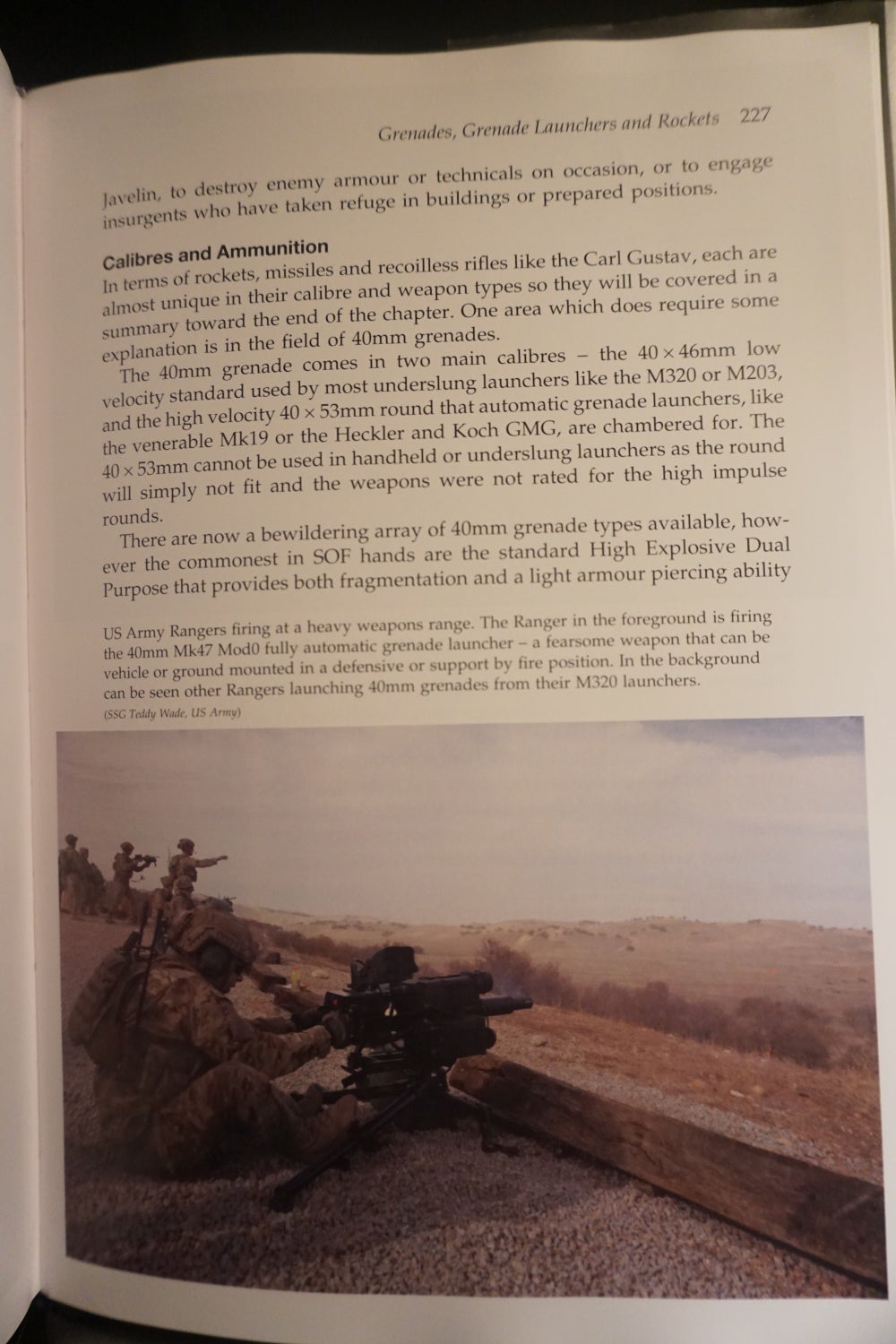
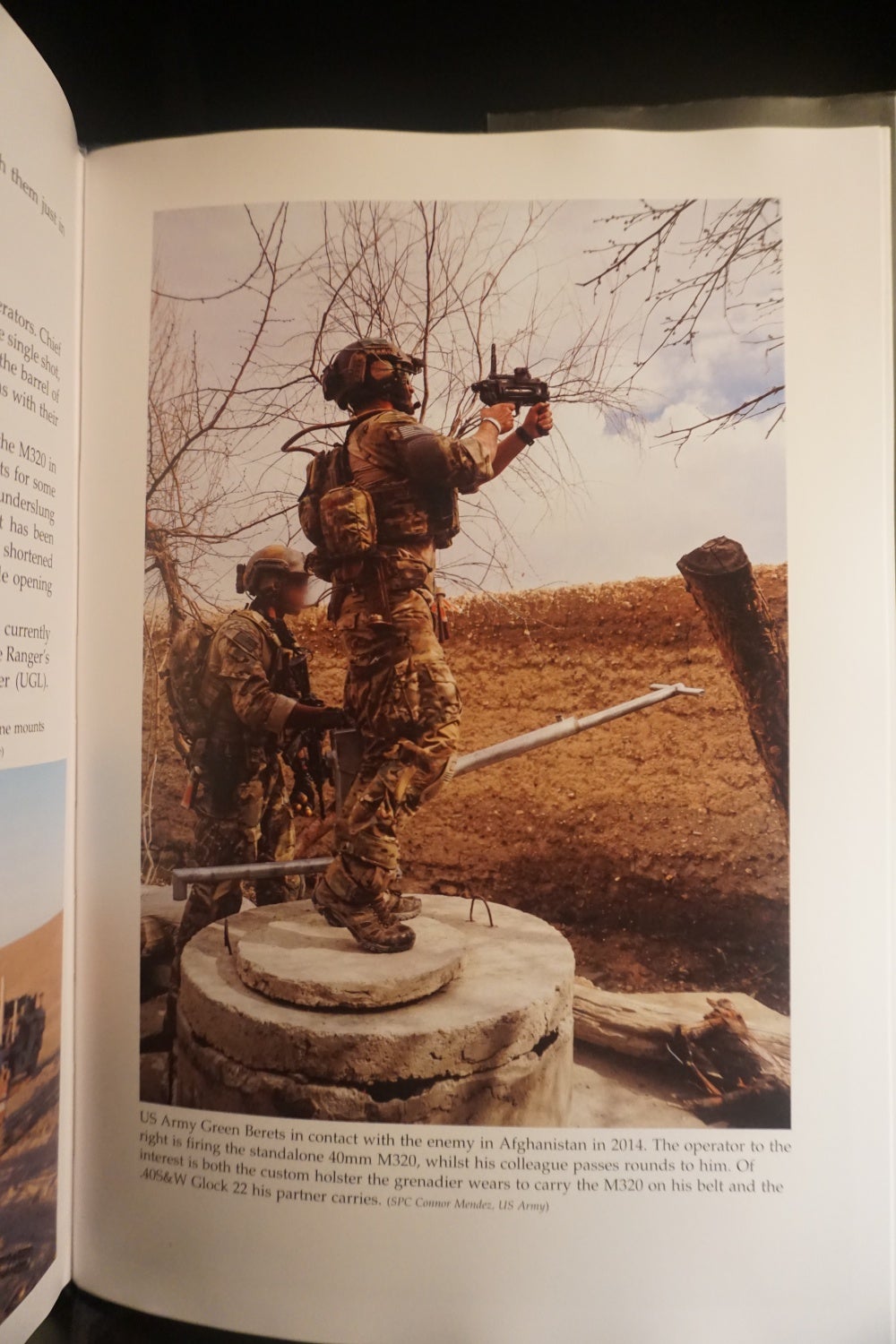
Detractions aside, I think the advantages of the book far outweigh the errors and points of issue. Asking for some more material on certain topics is almost really pushing the limit, for example explicit material on the Israeli and Russian sides of the SF story. For one, the language barrier is there, but also both of these countries are very secretive about their military actions and armaments. I mean, I personally probably couldn’t have written a better book, given the same ability and time to research the topic. Another good point on the book is that it is written by an Australian defense writer. Granted, Australia has absolutely done its SF part with regards to OIF/OEF, but frankly speaking, the development timeline has been lead first by American SF and then second by British SF contingents. Neville belonging to neither country can give a very objective look at this history, instead of being more partial to one or the other (Commonwealth and all…). Indeed I think his works are a positive step forward within Australian small arms scholarship, the only other major author being Ian Skennerton (pretty much the current world’s authority on the Lee Enfield), who has zero interest in modern day firearms. I’ll be anxious to read any more books from Leigh Neville!
 Your Privacy Choices
Your Privacy Choices
